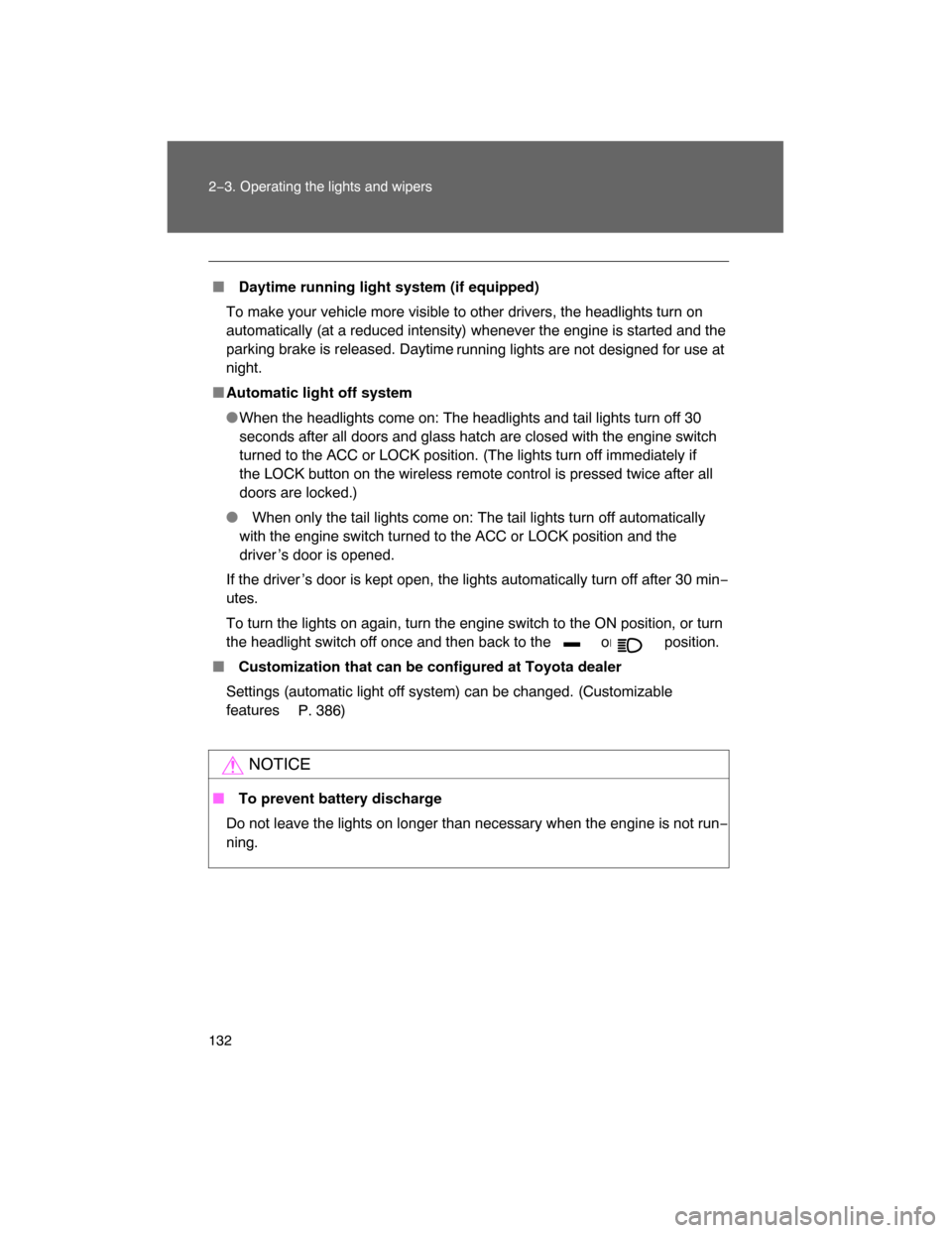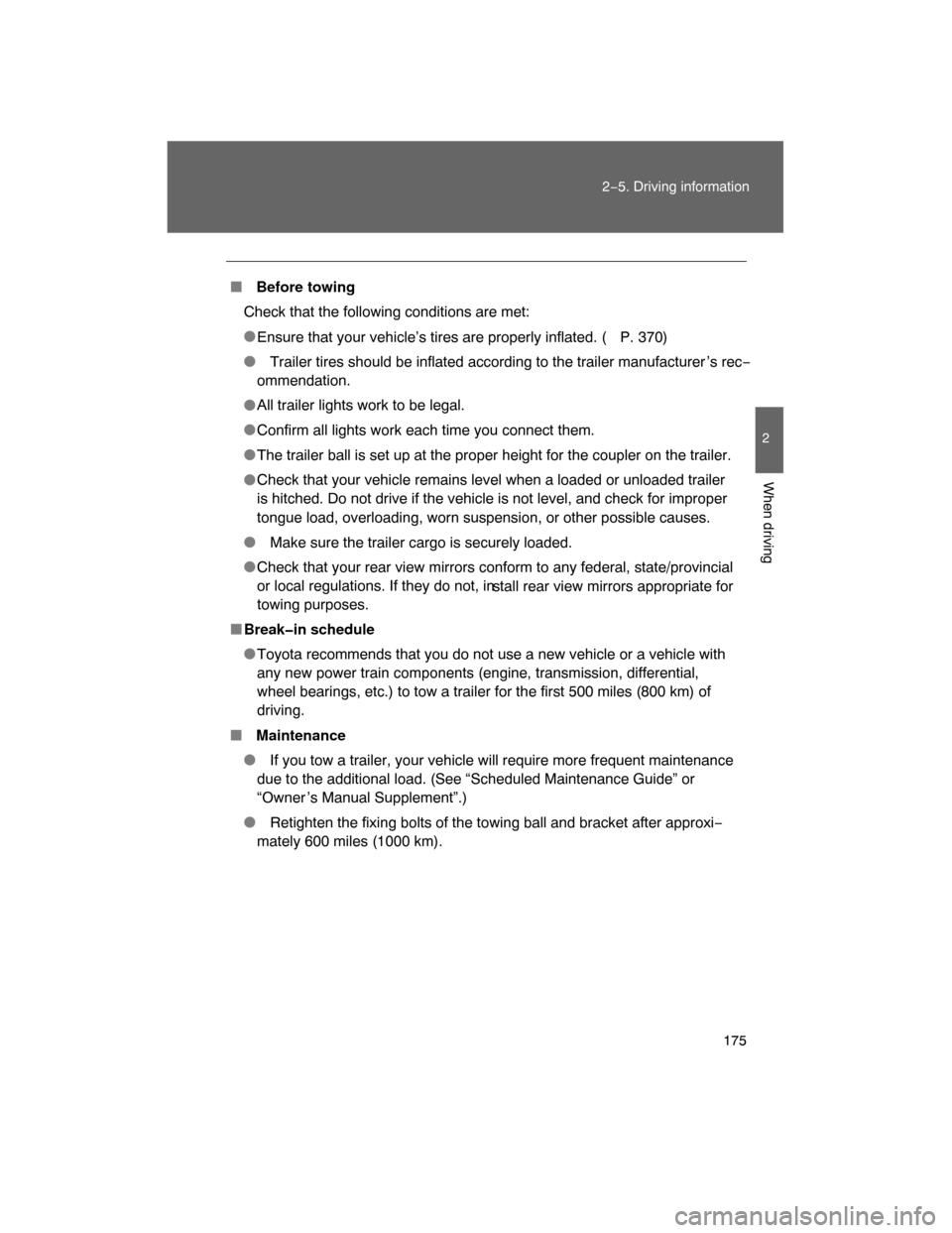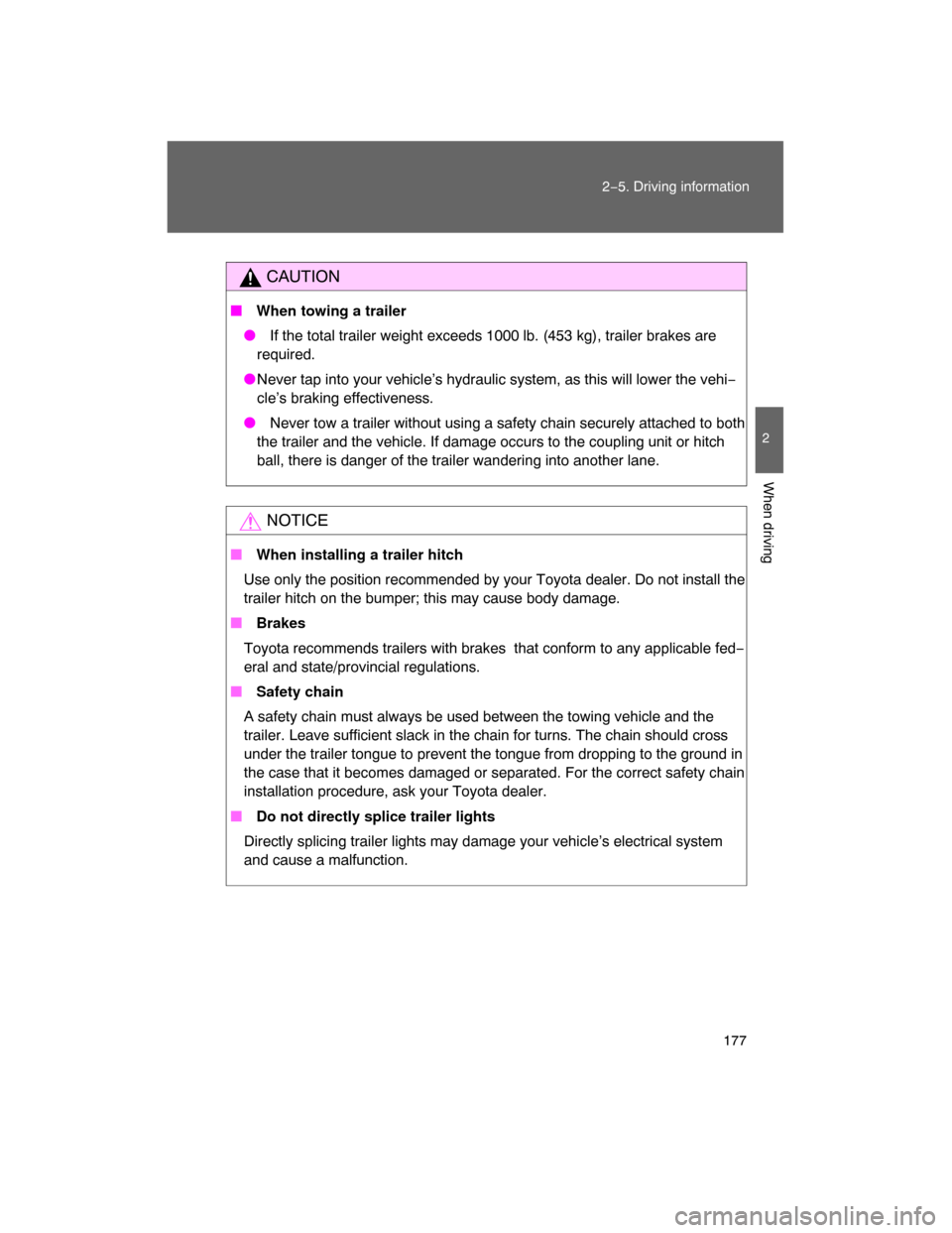Page 130 of 400

132 2−3. Operating the lights and wipers
� Daytime running light system (if equipped)
To make your vehicle more visible to other drivers, the headlights turn on
automatically (at a reduced intensity) whenever the engine is started and the
parking brake is released. Daytime
running lights are not designed for use at
night.
�Automatic light off system
�When the headlights come on: The headlights and tail lights turn off 30
seconds after all doors and glass hatch are closed with the engine switch
turned to the ACC or LOCK position. (The lights turn off immediately if
the LOCK button on the wireless remote control is pressed twice after all
doors are locked.)
� When only the tail lights come on: The tail lights turn off automatically
with the engine switch turned to the ACC or LOCK position and the
driver ’s door is opened.
If the driver ’s door is kept open, the lights automatically turn off after 30 min−
utes.
To turn the lights on again, turn the engine switch to the ON position, or turn
the headlight switch off once and then back to the or position.
� Customization that can be configured at Toyota dealer
Settings (automatic light off system) can be changed. (Customizable
features
P. 386)
NOTICE
� To prevent battery discharge
Do not leave the lights on longer than necessary when the engine is not run−
ning.
Page 131 of 400
133
2−3. Operating the lights and wipers
2
When driving
Windshield wipers and washer
Wiper intervals can be adjusted fo r intermittent operation (when INT
is selected.)
Intermittent wiper interval
adjustment (increase)
Intermittent wiper interval
adjustment (decrease)
Intermittent windshield
wiper operation
Low speed windshield wiper
operation
High speed windshield
wiper operation
Washer/wiper dual operation
Wipers will automatically oper−
ate a couple of times after the
washer squirts.
Page 132 of 400
134 2−3. Operating the lights and wipers
� The windshield wiper and washer can be operated when
The engine switch must be in the ON position.
�If no windshield washer fluid sprays
Check that the washer nozzles are not blocked and if there is washer fluid in
the windshield washer fluid reservoir.
NOTICE
� When the windshield is dry
Do not use the wipers, as they may damage the windshield.
�When there is no washer fluid spray from the nozzle
Damage to the washer fluid pump may be caused if the lever is pulled
toward you and held continually.
�When a nozzle becomes block
Do not try to clear it with a pin
or other object. The nozzle will be damaged.
Page 133 of 400
135
2−3. Operating the lights and wipers
2
When driving
Rear window wiper and washer (if equipped)
� The rear window wiper and washer can be operated when
� The engine switch must be in the ON position.
�
The glass hatch is closed.
NOTICE
� When the rear window is dry
Do not use the wipers, as they may damage the rear window.
Intermittent window wiper
operation.
The wiper operates 3 times at
normal speed and then moves
to intermittent mode.
Normal window wiper oper−
ation
Washer/wiper dual opera−
tion
Washer/wiper dual opera−
tion
The rear window wiper oper−
ates while the washer squirts.
Page 172 of 400
174 2−5. Driving information
Selecting trailer ball
Use the correct trailer ball for your application.
Trailer ball load rating
Matches or exceeds the gross
trailer weight rating of the trailer.
Ball diameter
Matches the size of the trailer
coupler. Most couplers are
stamped with the required trailer
ball size.
Shank length
Protrudes beyond the bottom of
the lock washer and nut at least 2
threads.
Shank diameter
Matches the ball mount hole
diameter size.
Connecting trailer lights
Use the wire harness stored in
the rear end underbody.
Page 173 of 400

175
2−5. Driving information
2
When driving
� Before towing
Check that the following conditions are met:
�
Ensure that your vehicle’s tires are properly inflated. ( P. 370)
� Trailer tires should be inflated according to the trailer manufacturer ’s rec−
ommendation.
�All trailer lights work to be legal.
�Confirm all lights work each time you connect them.
�The trailer ball is set up at the proper height for the coupler on the trailer.
�Check that your vehicle remains level when a loaded or unloaded trailer
is hitched. Do not drive if the vehicle is not level, and check for improper
tongue load, overloading, worn suspension, or other possible causes.
� Make sure the trailer cargo is securely loaded.
�Check that your rear view mirrors conform to any federal, state/provincial
or local regulations. If they do not, in
stall rear view mirrors appropriate for
towing purposes.
�Break�in schedule
�Toyota recommends that you do not use a new vehicle or a vehicle with
any new power train components (engine, transmission, differential,
wheel bearings, etc.) to tow a trailer for the first 500 miles (800 km) of
driving.
� Maintenance
� If you tow a trailer, your vehicle will require more frequent maintenance
due to the additional load. (See “Scheduled Maintenance Guide” or
“Owner ’s Manual Supplement”.)
� Retighten the fixing bolts of the towing ball and bracket after approxi−
mately 600 miles (1000 km).
Page 175 of 400

177
2−5. Driving information
2
When driving
CAUTION
� When towing a trailer
� If the total trailer weight exceeds 1000 lb. (453 kg), trailer brakes are
required.
�Never tap into your vehicle’s hydraulic system, as this will lower the vehi−
cle’s braking effectiveness.
� Never tow a trailer without using a safety chain securely attached to both
the trailer and the vehicle. If damage occurs to the coupling unit or hitch
ball, there is danger of the trailer wandering into another lane.
NOTICE
� When installing a trailer hitch
Use only the position recommended by your Toyota dealer. Do not install the
trailer hitch on the bumper; this may cause body damage.
� Brakes
Toyota recommends trailers with brakes that conform to any applicable fed−
eral and state/provincial regulations.
� Safety chain
A safety chain must always be used between the towing vehicle and the
trailer. Leave sufficient slack in the chain for turns. The chain should cross
under the trailer tongue to prevent the tongue from dropping to the ground in
the case that it becomes damaged or separated. For the correct safety chain
installation procedure, ask your Toyota dealer.
� Do not directly splice trailer lights
Directly splicing trailer lights may damage your vehicle’s electrical system
and cause a malfunction.
Page 223 of 400
226
3−3. Using the interior lights
Interior lights list
� Illuminated entry system
When the interior light switch is in the DOOR position, the interior light auto−
matically turns on/off according to whether the doors are locked/unlocked
and whether the doors are open/closed and the engine switch position.
� To prevent the battery from being discharged
If the interior light remains on when the door is not fully closed and the inte−
rior light switch is in the DOOR position, the light will go off automatically
after 30 minutes.
� Customization that can be configured at Toyota dealer
Settings (e.g. The time elapsed before lights turn off) can be changed.
(Customizable features
P. 386)
Front interior light (P. 227)
Rear interior light (
P. 227)
1
2